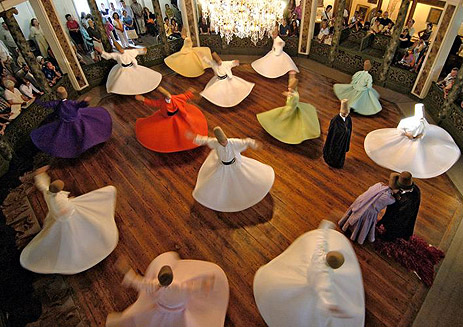Image Resource Bank
Image Gallery |  15 of 15
15 of 15 
The “Dance” of the Mevlevi Order
Mysticism is a form of religiosity known in almost all faith traditions. Mystics generally believe that the individual worshipper can attain the direct experience of being in the presence of (and sometimes filled with the spirit of) God. Their approach to religion is sometimes contrasted with that of more legalistic fellow-believers, who emphasize the need to know and observe revealed religious laws. In Islam, mystics are called Sufis, and mysticism is known as Sufism; while it, of course, differs in many specifics, some of the principles of Sufism are very similar to those of Christian mystics, like Meister Eckhart (d. 1328 CE), or Jewish kabbalah.
Since about the 12th century, Muslim mystics have generally been organized as “Orders” that follow the teachings of a prominent master mystic. The Mevlevi Order was inspired by the teachings of Jalal al-Din Rumi (d. 1273 CE) and founded shortly after his death. Its adepts use slow rotations to induce an experience of closeness to God; this led to them being called the “whirling dervishes.” Other mystical orders use different forms of spiritual exercise, such as long meditation or repetition of the name of God, to produce the experience of closeness to God.
Name: Mevlevi Dervishes
Material: Digital photograph
Size: 18.71 cm (7.36 in) x 13.23 cm (5.20 in)
Date: February 2006
Place of Origin: Turkey
Location: Wikimedia Commons
Registration # and Source:
Wikimedia Commons![]()
(accessed April 27, 2010)

 Fred M. Donner
Fred M. Donner
Professor of Near Eastern History, University of Chicago




